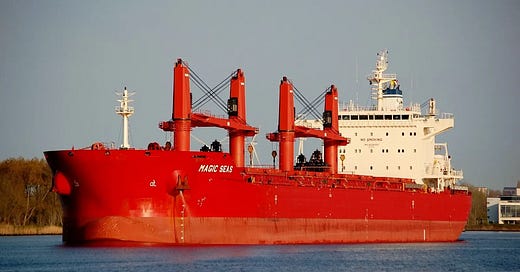Houthi-Style Maritime Attack Hits Bulk Carrier MAGIC SEAS in Southern Red Sea
Why Would the Houthis End a Seven-Month Pause on Maritime Attacks?
On July 6, 2025, at approximately 11:13 UTC, the Liberian-flagged bulk carrier MAGIC SEAS (IMO 9736169), carrying fertilizer from Zhuhai, China to Egypt, was subjected to a coordinated and aggressive maritime attack in the southern Red Sea.
The MAGIC SEAS is owned by STEM SHIPPING CO S.A., a global maritime transportation company founded in 2016 and based in Athens, Greece. The company is privately owned by the Bodouroglou family and operates a modern fleet of ten bulk carriers, two container vessels, and one tanker.
The incident took place around 51 nautical miles southwest of the port of Hudaydah, in waters located between the Yemeni Southern Red Sea Zubair Islands and Zuqar Island. This area has become a growing hotspot for asymmetric naval threats linked to the Houthis.
According to initial reports, multiple small boats approached the vessel and opened fire using light weapons and rocket-propelled grenades. Critically, multiple waterborne improvised explosive device (WBIED), a tactic strongly associated with previous Houthi operations, struck the hull of the ship. RPGs also hit the vessel’s bridge and fuel tank. The ship’s private armed security team returned fire. As a result of the assault, the vessel was left immobile and severely damaged.
Critically, mulitple waterborne improvised explosive device (WBIED), a tactic strongly associated with previous Houthi operations, struck the hull of the ship. RPGs also hit the vessel’s bridge and fuel tank.
Automatic Identification System (AIS) tracking data from MarineTraffic shows a sudden westward deviation in the ship’s course at the time of the incident. This change strongly indicates the moment the vessel came under attack and likely reflects an attempt to evade further damage or reposition defensively.
Although no group has formally claimed responsibility, the tactics used closely resemble those employed in past Houthi maritime operations. These include the use of WBIEDs, coordinated small-boat attacks, and the targeting of commercial ships transiting one of the world’s most important trade corridors.
This is the first such maritime incident bearing Houthi characteristics since November 18, 2024, when the Panama-flagged bulk carrier Anadolus S was targeted by a missile in the Gulf of Aden. That event occurred one day after a similar attempted strike on the same vessel. The seven month and 18 day gap between the November 2024 incident and the July 6, 2025 attack suggests not just an operational pause, but what we argue was a deliberate period of strategic recalibration.
While the timing of this most recent attack may come as a surprise to some, Basha Report had alerted its clients as early as 30 June 2025 to a noticeable uptick in chatter indicating a potential resumption of Red Sea operations.
While the timing of this most recent attack may come as a surprise to some, Basha Report had alerted its clients as early as 30 June 2025 to a noticeable uptick in chatter indicating a potential resumption of Red Sea operations.
But why now? The Houthis remained relatively quiet during the 12 day war between Iran and Israel, a calculated silence that now appears strategic. The group is eager to present itself as independent from Tehran, choosing a moment that serves its own interests rather than acting on Iran’s behalf. Although the Houthis later claimed they had launched drones and missiles toward Israel, their decision to delay the resumption of high profile Red Sea operations suggests a desire to appear deliberate and self-directed.
Although the Houthis later claimed they had launched drones and missiles toward Israel, their decision to delay the resumption of high profile Red Sea operations suggests a desire to appear deliberate and self-directed.
Their use of multiple WBIEDs and small fast attack boats in the July 6th assault also indicates a tactical shift. By avoiding the use of anti-ship ballistic and cruise missiles (ASBM/ASCM), which are believed to originate from Iran, the group appears to be conserving its limited missile stockpile. This reflects a practical adaptation to logistical limitations while still demonstrating operational strength.
By avoiding the use of anti-ship ballistic and cruise missiles (ASBM/ASCM), which are believed to originate from Iran, the group appears to be conserving its limited missile stockpile.
The timing may also be influenced by pressure from external actors. With United States envoy Steve Witkoff expected to meet Iranian Foreign Minister Abbas Araghchi in Oslo next week to restart nuclear talks, the attack could be intended as a subtle message to both Washington and Tel Aviv that Iran’s allied groups remain capable and active. Whether the action was coordinated or carried out independently, the message is clear. The Houthis still have the ability to disrupt and are carefully choosing when to act.
The connection between MAGIC SEAS and Israel is still under investigation, but the nature of the attack suggests it was likely deliberate rather than random. It likely serves as a message that the Houthis continue to possess the capability and willingness to strike at strategic maritime targets regardless of diplomatic developments.
The incident highlights the ongoing fragility of Red Sea maritime security and the importance of close monitoring, early warning systems, and regional coordination. Whether this marks a return to more frequent attacks or remains a singular escalation remains to be seen.







